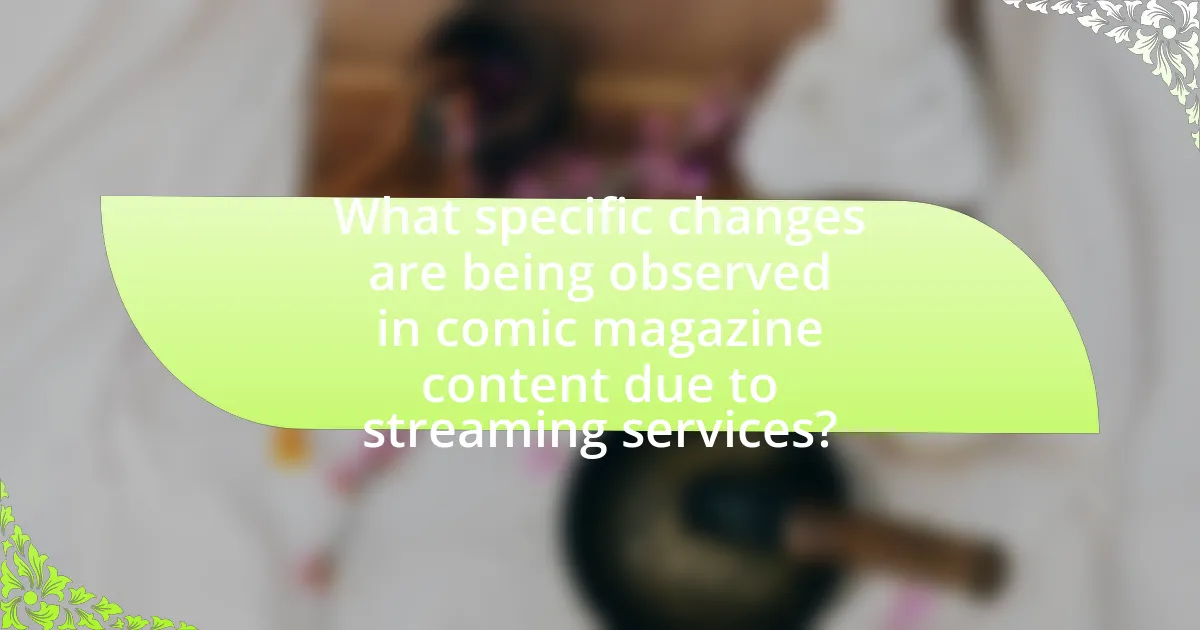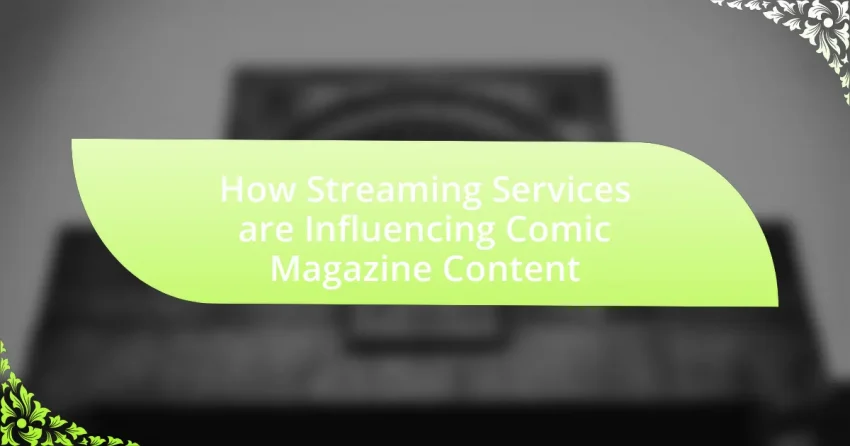Streaming services are significantly influencing comic magazine content by providing platforms for adaptation and distribution, which enhance visibility and accessibility. Popular platforms like Netflix and Disney+ have successfully transformed comic narratives into series and films, resulting in increased comic sales and renewed interest in original material. This article examines how streaming services shape the evolution of comic magazines, impact themes and narratives, drive audience shifts towards diversity, and influence character development. Additionally, it explores the future implications of these trends, including potential collaborations and technological advancements that may redefine comic formats.

How are Streaming Services Changing the Landscape of Comic Magazine Content?
Streaming services are transforming comic magazine content by providing platforms for adaptation and distribution, which increases visibility and accessibility. For instance, popular streaming platforms like Netflix and Disney+ have successfully adapted comic book narratives into series and films, leading to a surge in interest for the original comic magazines. This trend is supported by data showing that adaptations can boost comic sales; for example, Marvel reported a significant increase in comic sales following the release of related films. Additionally, streaming services often create original content based on lesser-known comics, introducing new audiences to diverse stories and characters, thereby reshaping the market dynamics of comic magazines.
What role do streaming services play in the evolution of comic magazines?
Streaming services significantly influence the evolution of comic magazines by providing a platform for adaptation and expanding audience reach. These services, such as Netflix and Disney+, have led to increased interest in comic-based content, prompting publishers to create new comic series or revamp existing ones to align with popular streaming adaptations. For instance, the success of shows like “The Umbrella Academy” on Netflix has resulted in a surge in comic sales and new storylines that cater to the audience drawn in by the series. This symbiotic relationship between streaming services and comic magazines fosters innovation in storytelling and art styles, ultimately reshaping the comic industry to meet the demands of a broader, more diverse audience.
How do streaming platforms influence the themes and narratives in comic magazines?
Streaming platforms significantly influence the themes and narratives in comic magazines by driving content trends and audience expectations. As these platforms adapt popular comic book stories into series and films, they create a demand for similar themes and character arcs in the original comic magazines. For instance, the success of adaptations like “The Umbrella Academy” and “The Boys” has led comic publishers to explore darker, more complex narratives that resonate with the serialized storytelling format of streaming content. This shift is evidenced by increased sales and readership of comics that align with the themes popularized by their adaptations, demonstrating a direct correlation between streaming content and comic magazine narratives.
What impact do streaming adaptations have on comic magazine sales?
Streaming adaptations significantly boost comic magazine sales. For instance, when popular comic-based series are adapted into streaming shows, sales of the original comic books often see a marked increase. A notable example is the adaptation of “The Umbrella Academy,” which led to a reported 300% increase in sales for the comic series by Gerard Way. This trend is supported by data from various publishers, indicating that adaptations create renewed interest in the source material, driving both new and returning readers to purchase comic magazines.
Why are comic magazines adapting to streaming service trends?
Comic magazines are adapting to streaming service trends to remain relevant in a rapidly evolving entertainment landscape. As streaming services like Netflix and Disney+ dominate viewership, comic magazines recognize the need to align their content with the serialized storytelling and visual engagement that these platforms offer. This adaptation includes creating content that can be easily translated into digital formats and multimedia experiences, appealing to a younger audience that consumes media primarily through screens. The shift is evidenced by collaborations between comic publishers and streaming platforms, such as adaptations of popular comic series into animated or live-action formats, which enhance visibility and attract new readers.
What audience shifts are driving changes in comic magazine content?
The audience shifts driving changes in comic magazine content include a growing demand for diverse representation and the influence of younger, digitally-savvy readers. These shifts are evident as comic publishers increasingly prioritize stories that reflect a broader range of identities, cultures, and experiences, responding to the expectations of a more inclusive audience. For instance, the rise of streaming services has popularized characters from various backgrounds, leading to increased interest in comics that feature these characters, as seen with the success of adaptations like “Ms. Marvel” and “Black Panther.” This trend indicates that comic magazines are evolving to cater to a more diverse readership, aligning their content with the narratives that resonate with contemporary audiences.
How do streaming services affect the creative direction of comic magazines?
Streaming services significantly influence the creative direction of comic magazines by driving content trends and shaping audience expectations. As streaming platforms like Netflix and Disney+ adapt comic book narratives for television and film, they create a demand for specific themes, characters, and story arcs that resonate with viewers. This shift encourages comic magazines to align their content with popular adaptations, often leading to the revival of classic characters or the introduction of new storylines that mirror successful streaming series. For instance, the success of Marvel’s cinematic universe has prompted comic publishers to focus on interconnected storylines and character development that appeal to a broader audience, reflecting the serialized nature of streaming content.

What specific changes are being observed in comic magazine content due to streaming services?
Streaming services are leading to a shift in comic magazine content by increasing the integration of multimedia elements and adapting narratives to align with serialized storytelling formats. This change is evidenced by comic magazines incorporating QR codes that link to animated content or soundtracks, enhancing reader engagement. Additionally, the demand for content that complements popular streaming series has prompted comic publishers to create tie-in issues and adaptations, reflecting the storytelling styles and character developments seen in these shows. As a result, comic magazines are evolving to become more interactive and interconnected with digital media, catering to a modern audience that consumes content across multiple platforms.
How are character developments in comic magazines influenced by streaming services?
Character developments in comic magazines are significantly influenced by streaming services through the adaptation of characters and storylines for television and film. Streaming platforms like Netflix and Disney+ have created a demand for diverse and complex narratives, prompting comic publishers to evolve their characters to align with contemporary audience expectations. For instance, the success of series like “The Umbrella Academy” and “The Boys” has led to comic adaptations that feature deeper character arcs and more intricate relationships, reflecting the serialized storytelling format popular in streaming content. This trend is supported by data indicating that adaptations often lead to increased sales and readership of the original comic material, as seen with Marvel and DC Comics, where characters gain renewed interest following their portrayal in streaming series.
What new character arcs are emerging in comic magazines as a result of streaming adaptations?
New character arcs in comic magazines are increasingly reflecting the complex narratives and character development seen in streaming adaptations. For instance, characters that were traditionally one-dimensional are now being portrayed with deeper emotional backstories and moral ambiguities, mirroring the multi-layered storytelling popularized by series like “The Boys” and “WandaVision.” This shift is evident in titles such as “Batman: The Imposter,” where Bruce Wayne’s psychological struggles are explored more profoundly, aligning with the darker tones of recent adaptations. Additionally, characters like Kamala Khan in “Ms. Marvel” are being developed to showcase cultural identity and personal growth, paralleling the themes presented in the Disney+ series. These changes indicate a trend where comic narratives are evolving to meet the expectations set by their streaming counterparts, enhancing character depth and relatability.
How do streaming services affect the diversity of characters in comic magazines?
Streaming services enhance the diversity of characters in comic magazines by providing a platform for varied narratives and underrepresented voices. These services often adapt comic book content into series or films, leading to increased demand for diverse characters that reflect a broader range of experiences. For instance, the success of shows like “Ms. Marvel” and “Black Panther” has prompted comic publishers to create more characters that represent different ethnicities, genders, and backgrounds, aligning with audience expectations for inclusivity. This shift is supported by data indicating that diverse representation in media can lead to higher viewer engagement and satisfaction, thereby influencing comic magazines to diversify their character offerings to attract a wider readership.
What genres are gaining popularity in comic magazines due to streaming services?
Superhero and fantasy genres are gaining popularity in comic magazines due to streaming services. The rise of platforms like Netflix and Disney+ has led to increased demand for content that aligns with successful adaptations of comic book properties, such as Marvel and DC films and series. This trend is evidenced by the surge in comic book sales related to popular streaming shows, with reports indicating that titles linked to these adaptations often see a significant boost in readership and sales figures.
Which genres are being prioritized in comic magazines to align with streaming trends?
Comic magazines are prioritizing genres such as superhero, fantasy, and horror to align with streaming trends. This focus reflects the popularity of these genres in streaming platforms, where superhero narratives dominate viewership, as evidenced by the success of Marvel and DC adaptations. Additionally, fantasy series like “The Witcher” and horror shows such as “Stranger Things” have driven interest in related comic content, leading publishers to adapt and create stories that resonate with these successful streaming narratives.
How do streaming services impact the storytelling techniques used in comic magazines?
Streaming services significantly influence the storytelling techniques used in comic magazines by promoting serialized narratives and character development. This shift occurs as comic publishers adapt to the binge-watching culture fostered by platforms like Netflix and Disney+, which encourages longer, interconnected story arcs that can engage readers over multiple issues. For instance, the success of streaming adaptations of comic properties, such as “The Umbrella Academy,” has led to comic publishers emphasizing cliffhangers and episodic storytelling to mirror the pacing and suspense found in television series. This adaptation is evident in the increased use of multi-issue storylines and character-driven plots, aligning comic magazines more closely with the narrative structures popularized by streaming content.

What are the future implications of streaming services on comic magazine content?
Streaming services will likely lead to a significant transformation in comic magazine content by prioritizing multimedia storytelling and character development. As streaming platforms increasingly adapt comic book narratives into series and films, comic magazines may shift towards more integrated storytelling that complements these adaptations, focusing on character backstories and expanded universes. This trend is supported by the success of adaptations like Marvel and DC properties, which have seen a surge in readership and viewership, indicating a growing audience demand for interconnected narratives. Consequently, comic magazines may evolve to include exclusive content that enhances the streaming experience, such as behind-the-scenes insights and interactive elements, thereby aligning their offerings with the multimedia consumption habits of modern audiences.
How might the relationship between streaming services and comic magazines evolve?
The relationship between streaming services and comic magazines is likely to evolve towards greater collaboration and integration. As streaming platforms increasingly adapt comic book narratives into series and films, comic magazines may see a rise in demand for content that aligns with these adaptations, leading to cross-promotional opportunities. For instance, Marvel and DC have already established successful synergies between their comic publications and cinematic universes, demonstrating that this trend can enhance audience engagement and drive sales. Furthermore, streaming services may invest in original comic content to complement their shows, creating a more immersive experience for fans and expanding the comic magazine market.
What potential collaborations could arise between streaming platforms and comic publishers?
Potential collaborations between streaming platforms and comic publishers include the adaptation of comic book series into animated or live-action shows, co-production of original content based on popular comic characters, and exclusive streaming rights for comic-related content. For instance, platforms like Netflix have successfully adapted comic series such as “The Umbrella Academy,” which has led to increased visibility and sales for the original comics. Additionally, streaming services may partner with comic publishers to create interactive content or behind-the-scenes features that enhance viewer engagement, leveraging the growing trend of transmedia storytelling. These collaborations can drive subscription growth for streaming platforms while providing comic publishers with new revenue streams and audience reach.
How could technological advancements in streaming affect comic magazine formats?
Technological advancements in streaming could lead to the evolution of comic magazine formats by integrating multimedia elements such as animations, sound effects, and interactive storytelling. This integration allows comic publishers to create a more immersive experience, appealing to a digital-savvy audience that prefers dynamic content over static images. For instance, platforms like Webtoon and Tapas have already begun incorporating these features, demonstrating a shift in how comics are consumed. As streaming technology continues to improve, comic magazines may adopt similar strategies to enhance reader engagement and attract new audiences, ultimately transforming traditional comic formats into more versatile digital experiences.
What strategies can comic magazines adopt to thrive in the streaming era?
Comic magazines can thrive in the streaming era by diversifying their content offerings and integrating multimedia elements. By incorporating digital formats such as webcomics, interactive storytelling, and augmented reality features, comic magazines can engage audiences who are increasingly consuming content through streaming platforms. For instance, the success of platforms like Webtoon demonstrates that readers are drawn to innovative formats that enhance traditional comic storytelling. Additionally, collaborating with streaming services to create exclusive content or adaptations can attract new readers and leverage the popularity of existing franchises. This strategy is supported by the growing trend of comic book adaptations in films and series, which have seen significant box office success, indicating a strong market for related comic content.
How can comic magazines leverage streaming trends to attract new readers?
Comic magazines can leverage streaming trends by creating content that aligns with popular streaming series and films, thus attracting new readers who are fans of those adaptations. By collaborating with streaming platforms to develop exclusive comic tie-ins or adaptations of popular shows, comic magazines can tap into the existing fanbase, increasing visibility and readership. For instance, the success of comic adaptations like “The Umbrella Academy” on Netflix has demonstrated that integrating comic narratives with streaming content can significantly boost interest and sales, as evidenced by the surge in comic sales following the show’s release.
What best practices should comic publishers follow to adapt to streaming influences?
Comic publishers should prioritize creating content that aligns with the storytelling techniques and pacing used in streaming media. This adaptation involves developing episodic narratives that can be serialized over multiple issues, mirroring the binge-watching culture of streaming platforms. Additionally, publishers should leverage multimedia elements, such as augmented reality features or interactive storytelling, to enhance reader engagement, similar to how streaming services incorporate viewer interactivity.
Furthermore, collaborating with streaming platforms for cross-promotional opportunities can expand audience reach and increase visibility. For instance, partnerships can lead to adaptations of popular comic series into animated or live-action formats, as seen with titles like “The Umbrella Academy” on Netflix, which has successfully transitioned from comic to screen, boosting comic sales and readership.
By implementing these practices, comic publishers can effectively respond to the influences of streaming services and remain relevant in a rapidly evolving entertainment landscape.
